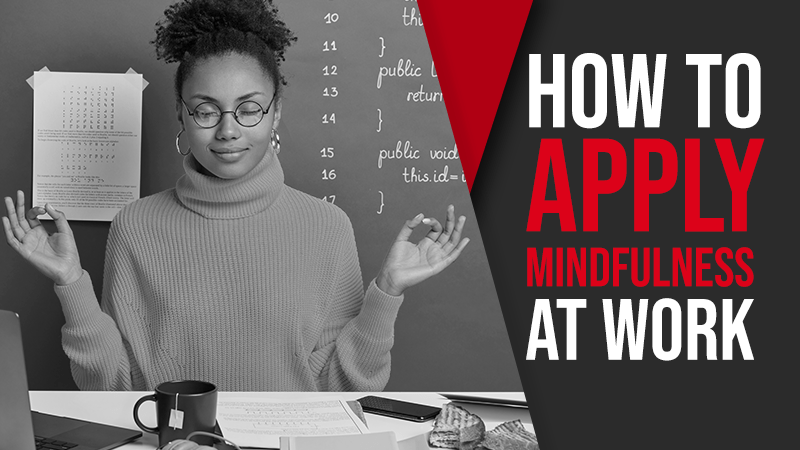5 Easy Steps on How to Apply Mindfulness At Work
Share this content :

Did you know that executives lose up to one hour of productivity daily because they have to sort through so many scattered files? Imagine if that happens in your mind. When your job is unfocused, doing anything in the workplace feels stressful. Managing multiple tasks will pull you in different directions. The confusion can overwhelm you.
Part of the blame goes to multi-tasking. So many people feel confident that they can do anything at once. We’re used to seeing people listen to office calls while driving or signing documents as they cook breakfast. However, this lifestyle is not healthy for any reason. Researchers found that four out of ten Americans find their jobs stressful, with many of them struggling to juggle multiple goals simultaneously. Face it: we’re simply not born to do it all alone.
Many companies have started to turn to meditation and mindfulness at work exercises. Over 200 million people worldwide practice meditating. They claim to feel more relaxed, sleep more hours, and feel more patient and energized at the start of the next day. If you want to know how to work better without losing your cool, here’s how you can start applying mindfulness at work.
Stick to One Task at a Time
Mindfulness at work teaches you to focus your thoughts on one task or idea at a time. Like what I said earlier, there’s too much stuff that people do at once. It’s like playing a game of twister, only that you’re trying to earn money as you tangle your body in the office. Instead of trying to put your feet and hands in different areas, keep your mind stuck on one simple thing. If you need to print, think only about printing. If you need to prepare for a big meeting, start with how you’ll dress. You can worry about the finer details after.
One example of practicing mindfulness at work is a meditation video. Do you sometimes wonder why those narrators tell you to think only about breathing? That’s because they know that the people who watch their content already have so much in their minds. They might be thinking of taxes or deadlines or other problems. When they tell you to clear your mind and concentrate on each breath, it gives your mind an anchor to stick to. This way, you can stay adrift in your thoughts as you do one task. More importantly, you give your brain less time to think of other things, which means less stress to get hung up on.
To start, write up a list of tasks you have for the day. Think about the most challenging and time-consuming ones first. After that, draw a simple ladder or stairway. Put the toughest tasks at the bottom and put the easier jobs ahead. At the top, write “JOB WELL DONE” in bold letters. Now, you have a visual roadmap to doing your job for the day or week. Remember to stick to the path, don’t skip any rungs or steps on your way to a job well done.
Fall Asleep and Wake Up Properly
What is the first thing that you do upon waking up? Your initial activity in the morning can set the tone for the rest of the day.
Many people immediately jump to their phones to check their emails, timelines, and messages before they even start to leave the bed. This is a bad habit to begin with because checking your phones and all your apps upon waking up are forcing your mind to work. It’ll be like starting the car and suddenly pushing the gas pedal to try and hit 200 kph. That would overheat your engine before you even leave the garage. Mindfulness at work reminds us that you must slow down and take things piece by piece. This includes rest: you can’t rush your body, no matter how hard you try. Doing so will only leave you exhausted.
The best way to counteract this is by leaving your phone off. Don’t turn it on until after you’ve been awake for at least ten minutes. Instead, take the time to walk around the room or watch the sunrise. A slow start is an excellent way to activate your mind and prepare it for the day’s tasks. Always remember that slow and steady is the way to go. Don’t rush your morning. Instead, relax and let your brain fully awaken before you start working.
You should also apply this habit when you are about to sleep. So many adults have insomnia because they stay on their phones late into the night. The blue light emitted from the screen keeps your brain stimulated, so sleep takes longer to set in. By the time you go to dreamland, you’ve only got four hours or less to recharge. To compensate for this, consider keeping your phone off for at least an hour before you fall asleep and after you wake up. That’ll give your mind enough time to relax for rest and work.
Set Work to Specific Times and Places
Turning off your thoughts from work can be challenging, especially for those who have home set-up offices or work in virtual spaces. Many workers find it hard to relax once their job ends for the day. Even as they go back home or sign out for the day, their mind is stuck on what tomorrow’s load will be. In other words, even when the clock says work is over, your mind is still in the cubicle.
Mindfulness at work teaches us to pay attention to the present moment. It means ignoring all upcoming tasks or past mistakes. It’s the here and now where work gets done.
For people with busy schedules, always remember that everything has a time and place. When you’re at home, try turning off your push notifications. The less you hear that ringtone, the less often your mind shifts back to work. Remember, home is where you rest and recover. Don’t bring your work back home unless necessary. If you have to, set a time for when you work and when you stop. When you limit where and how you work, you learn to reorganize and focus when the time is right.
Accept Stress As Part of Life

When you’re still young, it might seem like signing up for a retirement savings plan isn’t a priority yet. The focus could be on travels, enjoyment, anything that will make you feel you earned your salary. Right now, you might still have 30 or 40 years before retirement, so you might think you still have plenty of time. The catch is that retirement savings have special tax-advantaged accounts. Accounts like 401(k) and Individual Retirement Account (IRA) limit the amount that you can contribute each year.
Instead of worrying about stress, learn to accept it. Mindfulness at work teaches us to be aware of our surroundings. We don’t try to change the world around us. That includes the stress you face in your workspace, from your performance feedback to your output revisions. It will happen and can make you do faster and better work if you take it gracefully.
Also, remember that if you are stressed, you should find outlets for it to go away. All that negative energy in your mind can’t stay within the body. Some people lash out because they’ve had so much unreleased anger inside. If you need to blow off steam, try exercising with a nice walk around the block or reading your favorite book for ten minutes. By turning negative energy into something good, you’ll feel much better and more prepared for the day ahead.
Be Mindful Of Your Peers
Even if you are mindful and calm, enjoying the present when everyone is stressed can be challenging. Your colleagues might also be upset or tired. That’s the time you should step in and encourage others to meditate with you. When everyone takes the time to breathe and relax, they can focus again. Like a machine, every cog and gear needs the same care as the entire thing.
Consider speaking with your friends and officemates about having time to meditate together. You can do this before work begins, during recess, or after the shift ends. Together, you can all share your thoughts and time your breathing. Getting more peers to join you makes your office space more relaxing and tranquil. More importantly, you make new friends or build a deeper trust with each other. If you want to take this outside the workplace, choose a nearby place where you all can meet up and enjoy a class together. For example, you might enjoy intensive yoga sessions in a local studio.
In Summary
Ultimately, being mindful is to be aware of where you are at the moment. Where you stand right now is the reality you face. You learn just how simple the task can be by pushing away any imaginary scenarios or pressing concerns.
Once you envision your goal and stick to the path, you might be surprised how quickly and easily you can accomplish your work.
Share this content :
Copyright © 2023 Munif Ali. All rights reserved.

